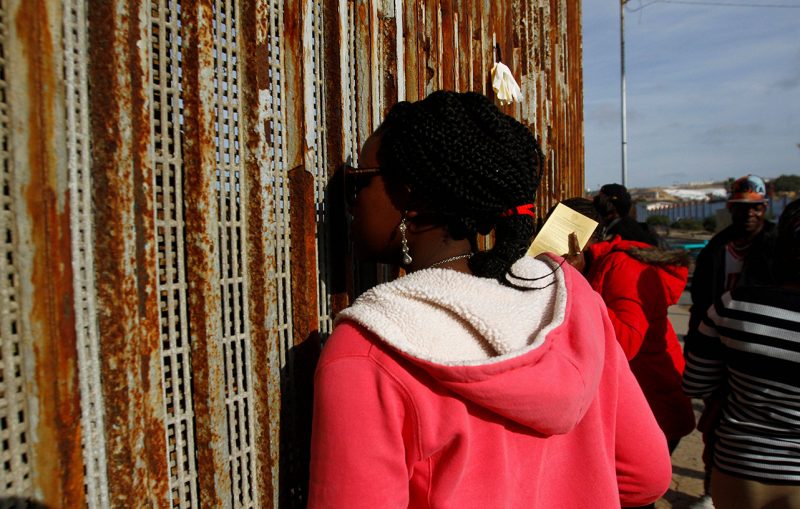On January 25 of this year, the President of the United States of America, Donald Trump, signed the executive order titled "Improvements in border security and immigration enforcement.". Its objective is "guarantee the security and territorial integrity of the United States and ensure that immigration laws are faithfully enforced".
The measures for its implementation include, among others, the planning, design and construction of a "barrier" on the southern border with Mexico, defined in the text as a "... barrier".physically impassable adjacent wall". The action plan also foresees the control and construction of additional detention centers for foreigners in addition to the existing ones; the increase in the detention of undocumented aliens and the hiring of 5,000 additional border agents.
The second point has begun to be implemented. In February, Immigration and Customs Enforcement conducted raids in several states, which resulted in the arrest of hundreds of undocumented aliens, or "undocumented aliens". paperlessfor their deportation. Several newspapers spoke of "panic". The actions took place in homes and workplaces in Atlanta, New York, Chicago, Los Angeles, North Carolina and South Carolina.
In the middle of the month, Mexico's Foreign Minister Luis Videgaray reported that there had not yet been any mass deportations from the United States. On the other hand, on Sunday the 12th, protest marches against President Trump's immigration policies took place in different Mexican cities.
Mexico, a great unknown
Although the U.S.-Mexico bilateral relationship is one of the most important for both nations (united by their geography, history, communities and trade), for the average American, particularly for those who voted for the New York magnate, the neighbor to the south is the great unknown.
President Trump has decided to set aside the facts, the history of the relationship and its reality to rely on anti-Mexican and racial prejudices, many of them well rooted in the collective imagination of the common American. Within that imaginary, Mexico is neither a partner, nor a friend, nor a neighbor, but the place where there are poor and good people, but also many "bad hombres" (Trump dixit), who go to the U.S. to break laws, steal jobs from Americans, cross drugs across the border and commit crimes. Therefore, according to the president, the only solution is a "wall capable of stopping all the evils coming from the neighbor to the south".
With working life
The real fact is that throughout history there has never been a military or terrorist attack from Mexico (the only incursion was Pancho Villa's raid on Columbus, New Mexico, in 1917).
Another fact ignored by Trump is that a portion of the 11 million undocumented immigrants currently living in the United States entered legally on tourist visas. And while they did indeed violate the terms and conditions of their stay in the country, wall or no wall, they would have entered.
And now they have joined the working life of the United States. They are people who with their work and taxes contribute to the greatness of the nation, which according to President Trump has vanished but he will be able to give it back to them. (Make America Great Again, "make America great again" was his campaign slogan).
In addition, of the millions of people who cross the border daily, only a small percentage do so without documents, but most are apprehended and repatriated to their countries of origin.
The construction of a wall is unthinkable in many parts of the southern border. A good part of the 3,140 kilometers of border already has some type of wired or concrete fence. In other areas, the physical barrier is nature itself: the Rio Grande, the desert or other natural areas, some of which are ecological reserves protected by federal law.
Another factor is that much of the land on which the fence would have to be built is privately owned, mostly in Texas. To build it, the federal government would have to buy thousands of miles or proceed to expropriate it, in which case it would face long and costly legal battles not only with the owners, but with entire counties and border cities. It would be a struggle of the executive branch against federal, state, municipal and private powers.
Cross-border cities
Another obstacle is the existence of dozens of regions on both sides of the border that are "borderless".cross-border cities"In other words, regions that are so economically and socially integrated that they function as if they were a single city. This is the case of Tijuana, Baja California and San Diego (California); Nogales, Sonora and Nogales (Arizona); Ciudad Juarez, Chihuahua and El Paso (Texas); Nuevo Laredo, Tamaulipas and Laredo (Texas); Matamoros, Tamaulipas and Brownsville (Texas).
Mexico's border with the United States is the busiest in the world. Its cities are places where hundreds of Mexican workers work legally on one side but live on the other, and therefore cross it daily. Places where American citizens go to obtain medical services in Mexico, because they are up to 80 % cheaper, of high quality and without the inconvenience of the American government bureaucracy.
Integration in these cross-border cities is not only economic, but also social and cultural. In many regions, festivals are held every year to recognize their friendship and cooperation. These events highlight the traditions, art and culture of the two peoples. A typical case is the Friendship Festival, which is celebrated every year in the city of Del Rio (Texas), in which hundreds of people and floats from the neighboring city, Ciudad Acuña, in the State of Coahuila, participate.
Debate on cost
Perhaps the biggest hurdle Trump's wall will face will be the cost. To build it could require, according to some estimates, more than $20 billion. A cost that does not include all the items that President Trump mentions in his decree, such as the construction of more detention centers for undocumented immigrants, the escalation of deportations, and above all the hundreds of lawsuits he will have to face in the event of expropriation of land.
Who will pay for it? The reality is that the pockets of American citizens, even though Trump has repeatedly said that "the US will pay for it.Mexico will pay the full cost of the wall". The tycoon claims that this could be done by imposing a 20 % tax on all Mexican goods. Something that could not be done today because both countries are signatories to the North American Free Trade Agreement. In addition, both nations are members of the World Trade Organization (WTO). This practice of imposing tax tariffs against a single country would be a violation of the WTO statutes.
In the middle of the month, President Trump came out against the figures offered by Reuters, contained in an internal report of the US Department of Homeland Security. The cost would reach $21.6 billion, up from the $12 billion that Trump spoke of in the campaign. However, the president assured that, once "be involved"in its design, "the price will drop dramatically". "I'm reading that the big cross-border wall will cost more than the government thought, but I'm not yet involved in negotiations or the design. When it does, as happened with the F-35 fighter or the Air Force One program, the price will come down a lot.", wrote the president.












